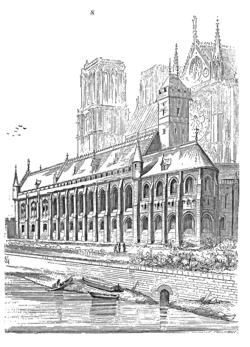You can help expand this article with text translated from the corresponding article in French. Click for important translation instructions.
|
| Archbishop's Palace of Paris | |
|---|---|
|
| |
 The Palace in the Middle Ages as imagined in Dictionary of French Architecture from 11th to 16th Century (1856) by Eugène Viollet-le-Duc The Palace in the Middle Ages as imagined in Dictionary of French Architecture from 11th to 16th Century (1856) by Eugène Viollet-le-Duc | |
| General information | |
| Location | South of Notre Dame de Paris, Paris, France |
| Coordinates | 48°51′09″N 2°20′59″E / 48.852572°N 2.349591°E / 48.852572; 2.349591 |
| Construction started | 1161 |
| Renovated | 1697 |
| Destroyed | 13 February 1831 |
| Owner | Archdiocese of Paris |
The Archbishop's Palace of Paris (French: Palais de l'Archevêché de Paris or the Palais Archiépiscopal) was the residence of the Archbishop of Paris, located just south of the Notre-Dame de Paris. It was built in 1161 and destroyed in 1831.
History
It began as the bishop's residence for Maurice de Sully in 1161. The bishopric was elevated to an archbishopric in 1622, and in 1697 the palace was entirely rebuilt by Cardinal de Noailles, except for the chapel, which still existed in 1830. During the French Revolution of 1789, the Constituent Assembly held meetings in it. Afterwards it was inhabited by the chief surgeon of the city's main hospital, the Hôtel Dieu. The chapel, the oldest structure in the complex, became an amphitheatre of anatomy. In 1802 it was restored to the clergy, and Cardinal de Belloy took up residence in it. The palace was destroyed by a revolutionary mob on 13 February 1831.
-
 Plan
Plan
-
 View of the Archbishop's Palace (at left) painted by Raguenet in 1756
View of the Archbishop's Palace (at left) painted by Raguenet in 1756
Project of Viollet-le-Duc
In 1859, during the period of the Second French Empire, the architect Eugène Viollet-le-Duc drew up plans for the construction of a new palace on the northeast side of the cathedral, but they were never carried out.
-
 Project for a new palace, created by Viollet-le-Duc in 1859
Project for a new palace, created by Viollet-le-Duc in 1859
Notes
- Galignani 1830.
- Galignani 1853.
Bibliography
- Galignani, Anthony (1830). "Palais Archiépiscopal", pp. 206–209, in Galignani's New Paris Guide, July 1830. Paris: A. and W. Galignani.
- Galignani, Anthony (1853). "Archbishop's Palace", pp. 338–339, in Galignani's New Paris Guide, for 1853 (at Internet Archive). Paris: A. and W. Galignani and Co.